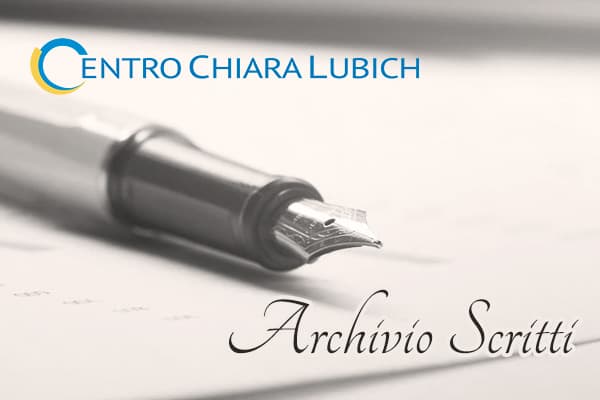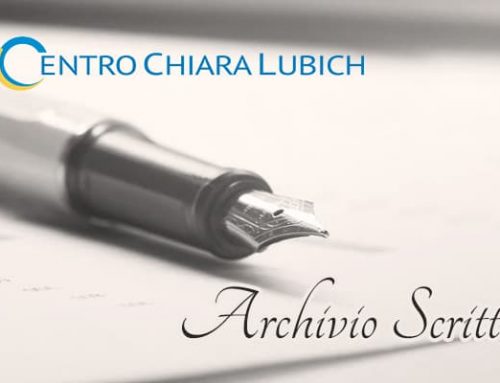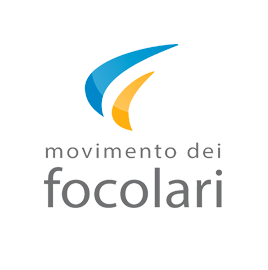April 20, 1958
Looking through the issues of Citta’ Nuova magazine, the periodical founded by Chiara Lubich in 1956, right from the very first issue you discover a treasure chest of her writings and spiritual thoughts.
There you can truly experience the atmosphere of the day, rapidly conveying facts and news at first hand from the countries in which the Movement was putting down roots.
This is what we see in the editorial signed by Chiara (shown by three asterisks) of 20th April 1958 with the headline “Jesus at Expo ’58”
Writing in an incisive and effective way, the author outlines the impressions she had on visiting the Expo in Brussels in the Spring of that year.
She starts by describing the Atomium, the symbol of the atom which “towers over almost all of Brussels and can be seen from many parts of the city. It sets the tone for the Expo, which displays the discoveries and the products of the atomic age”. Chiara had gone to Belgium for Easter Week. At the time the Movement was just starting to spread beyond the Alps, into the heart of Europe.
It is clear, then, why this event made such an impression on her.
On April 17th the International Exhibition in Brussels was opened. We visited it a few days ago when the pavilions were still under construction and the participating nations had not yet put in place the products of their country nor the discoveries of their scholarship.
However, we could already have an idea, even from the outside, of what is now being offered on display to the general public from all over the world. It’s something truly impressive.
The greatest powers, the greatest states from all five continents are competing to show off the best outcomes of their talents. Truly, having seen Brussels in the last few days, one knows a lot more about modern progress.
A citizen from any nation at all, if they have an understanding of universality and love for humanity today, could feel proud to be living in this century which – as far as one can tell -has little to envy in the great eras in history and the most highly developed civilisations.
The symbol of the exhibition, placed at the center, is an enormous structure called the “Atomium” made up of nine huge spheres projecting upwards. The “Atomium” towers over almost all of Brussels and so it can be seen from many parts of the city. It sets the tone for the Expo, which displays the discoveries and the products of the atomic age.
All around it, many pavilions have been erected. Some are magnificent and impressive like the ones put up by America, Russia and France; others less so like those of England, the Arab States, Yugoslavia etc. Looking at these very modern constructions which are so innovative in their design, colors and lighting, but have usually been put together in a balanced and harmonious way, with the most varied and original architectural styles, one cannot but look on in admiration.
Seeing these most amazing structures and ever new styles, one discovers the brilliant new ideas of our century, whether in shapes that are graceful or bold, narrow, transparent or sturdy; sometimes in the form of a cube or a sphere or a cylinder, with expressions of folklore and of religion too. They are real masterpieces, unknown to most of us until now, and each one bears the hallmark of its people, of its tradition, of its own taste.
The pavilion that drew our attention in a special way however was the one set up by the Holy See. It stands almost opposite the Soviet pavilion and next to the American one.
Its name is “Civitas Dei” (City of God). At its heart there is a church which is simple and harmonious in style, maybe because it is so rich in content; it is very elegant and extremely modern. Around it there are rooms like little amphitheaters.
Seeing this complex, and naturally comparing it with biggest and most magnificent pavilions close by, one experiences a deep joy at being catholic, not only from a religious point of view but also because of the external appearance of the building which is both ambitious and original. The various parts of the pavilion express only one idea, which is highly significant: the Church of the fishermen, the Church of Peter, the Church of the Pope. In fact the roof of this pavilion, like that of others, is like a huge net, with tie-beams falling vertically as if they were forming a colonnade with beautiful magnificent windows in between that serve as a side wall.
As you go into the church, at the back opposite the main altar, one can see the convex roof, not at all like our vaults, but which from the center towards the apse soars upwards into a wonderful point of convergence where the net should be drawn together by the fishermen after the catch. This idea, which is so genial and so well expressed, makes your soul feel it is being lifted up towards God, like an angel’s flight towards heaven. Underneath this stands an altar where Mass will be continuously celebrated. At the front of the church is a tall, thin façade which makes you think of a huge shield, made of fine stonework. On top of the church is a beautiful little cross and it seems it wants to say to the world, gently but firmly: “they will not prevail against it”.
In front of the church there is a lattice bell tower with thirty six bells of different sizes, reinforced by a good number of loud speakers. From here the call to the Lord will echo out to the whole site of the Expo. In the rooms beside the church, priests from many different countries will explain what the Catholic Church is to thousands of visitors. So it is the living Jesus, who continues to sacrifice himself for everyone, and the word of truth of a King who is not of this world, which are the riches put on show in Brussels by the “City of God”, whereas nearby, among other things there are an atomic ice-breaker, Sputnik II and a huge statue of Lenin that fill the Soviet Pavilion. A blow up theatre and many expressions of modern art and folklore fill the American Pavilion.
Yes, Jesus is at the Brussels Exhibition, just as one day Jesus was at the marriage-feast at Cana. The Son of Man does not disdain to get involved in all human activities, and through the harmonious peal of the bells he will give a reminder of what is eternal and divine to all those who gather there, to exalt the talents of all the peoples He created. It is Jesus who dies on the altar for everyone, also for those who don’t care about him, who are perhaps filled with pride in their knowledge and their discoveries, or who may even fight against him. It is Jesus who still teaches the Truth through those of whom he said: “Whoever listens to you listens to me”.
These are the gifts and the “produce” of the Catholic Church which continues Him. Jesus in the Eucharist is the fruit of the Church, just as in the past Jesus of Nazareth was the fruit of the most pure womb of the Virgin Mary. And there at “Expo 58” as in every church of ours, Jesus will try to quench people’s thirst for light, love, courage and strength. Jesus makes himself known, or rather he shows his tangible love. He offers himself to save people there too, where everything speaks of atomic energy, technology, inventions, and newness. He is the greatest new thing, the eternal discovery who is never discovered. He is the One who will remain, even when in future centuries no one will remember much about the exhibition in Brussels, just as no one today knows the names of the couple married at Cana.
He is there so as not to let us down, so as to fill the emptiness that will be created in many people – despite the “showing off” of the most beautiful treasures of our day – when they experience the vanity of everything, even of all that is great, but is not rooted in God.
When the Expo finishes in October, there will be a summing up and an assessment of the results of this great exhibition.
Jesus too will draw his conclusions and Heaven will see what the Grace of God has brought about, through the Holy See’s Pavilion, which calmly but appropriately sets spiritual and divine strength in opposition to the turmoil of materialism, technology and capitalism. And only because of Him will much of what we have seen and praised today remain for the benefit and support, the satisfaction and comfort of humanity.
While going along one of the elevated walkways that link the various parts of “Expo 58” we heard a visitor talking about the Holy See’s pavilion, saying: “Here one can see a Church which is young.” So let’s remember the words that are said at every Mass, celebrated even by the oldest priest, as he goes onto the altar: “To God who gives joy to my youth.”
Chiara Lubich
Translation from Citta’ Nuova 20 Aprile 1958



